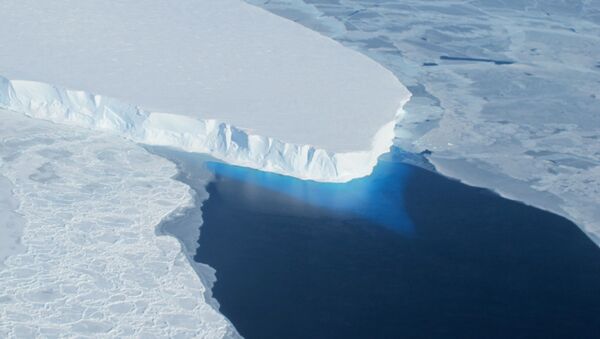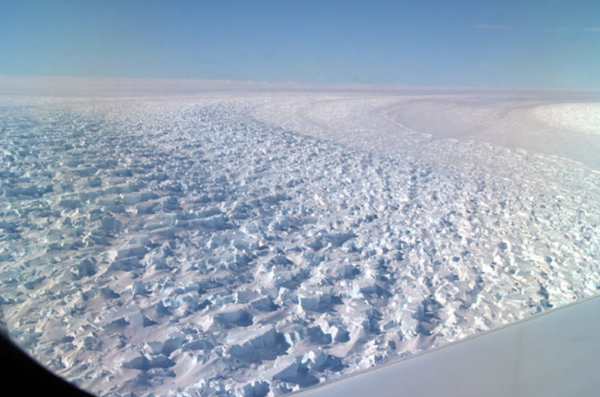Thwaites Glacier, known as the “Doomsday Glacier”, has caused alarm among scientists who warn that it is increasingly likely to live up to its nickname.
Studies have shown it is melting at an increasingly rapid pace, with potentially catastrophic effects.
According to PBS NewsHour, David Holland, New York University’s Professor of Mathematics and Atmosphere and a member of the International Thwaites Glacier Collaboration, said:
“It's a major change, a rewriting of the coastline.”
The glacier in western Antarctica which is roughly the size of Great Britain is estimated to be retreating by about half a mile (800 metres) a year, and is on course to shed all of its ice in between 200 and 600 years.
Though that event is calculated to raise sea levels by up to 2 feet (0.5m), it is not the sole concern.
Since the glacier at present acts as a buffer between the warming sea and other glaciers, its collapse is fraught with catastrophic possibilities.
Neighbouring ice masses in western Antarctica could be brought down along with it, experts claim, raising sea levels by nearly 10 feet (3 metres) and permanently submerging many coastal areas including parts of New York City, Miami, and the Netherlands.
Two studies in September have already fed these concerns.
Research published last week in the journal The Cryosphere entitled, “Deep channels link ocean to Antarctic glacier”, revealed that warm ocean currents might be eating away at the underside of the Thwaites Glacier.
According to researchers from the International Thwaites Glacier Collaboration, who gathered data from the glacier and adjoining Dotson and Crosson ice shelves between January and March 2019, channels beneath the Thwaites Glacier may be presenting a pathway for warm ocean water to melt the ice from the bottom upwards.
Another study published on 14 September in the Proceedings of the National Academy of Sciences, used satellite imagery to zoom in on sections of the Thwaites Glacier and its neighbouring Pine Island Glacier that are breaking apart more quickly than previously believed.
Thinning and grounding line retreat in the Pine Island and Thwaites Glaciers could drive ice shelf instability and mass loss in the Amundsen Sea Embayment. In PNAS: https://t.co/rZpjUqKech pic.twitter.com/Fld9smXV98
— PNASNews (@PNASNews) September 16, 2020
The research, “Damage accelerates ice shelf instability and mass loss in Amundsen Sea Embayment”, found that shear margins on the two glaciers have been weakening and breaking apart, potentially allowing ice to flow into the ocean.
The shear margins are sections where fast-moving glacier ice encounters slower-moving ice, which keeps it contained. Accordingly, the melting is speeding up, said Stef Lhermitte, a satellite expert at Delft University of Technology in the Netherlands who led the research accompanied by colleagues from NASA and research centres in France, Belgium, Austria, and the Netherlands.
Stretching across a frozen plain more than 150 miles long, these glaciers, named Pine Island and Thwaites, have marched steadily for millennia toward the Amundsen Sea, part of the vast Southern Ocean. pic.twitter.com/XBpaDVYH2l
— grist (@grist) November 21, 2017
The study offers graphic before-and-after images taken from space that not only reveal what is happening to the glaciers, but allow scientist to forecast how they will diminish.
"What the satellites are showing us is a glacier coming apart at the seams," Ted Scambos, a senior research scientist at the University of Colorado, was cited as saying.
Another great #IceBridge flight over Thwaites and Pine Island Glaciers today. Great views of the fast growing rift. pic.twitter.com/2tjToQ23
— NASA Ice (@NASA_ICE) November 13, 2011
On a broader scale, the Antarctic ice sheet is melting six times faster than it was in the 1980s, losing 252 billion tons annually, up from 40 billion tons per year 40 years ago. Scientists estimate that sea levels would rise by 200 feet (60 metres) if all the Antarctic ice sheet were to melt away.





